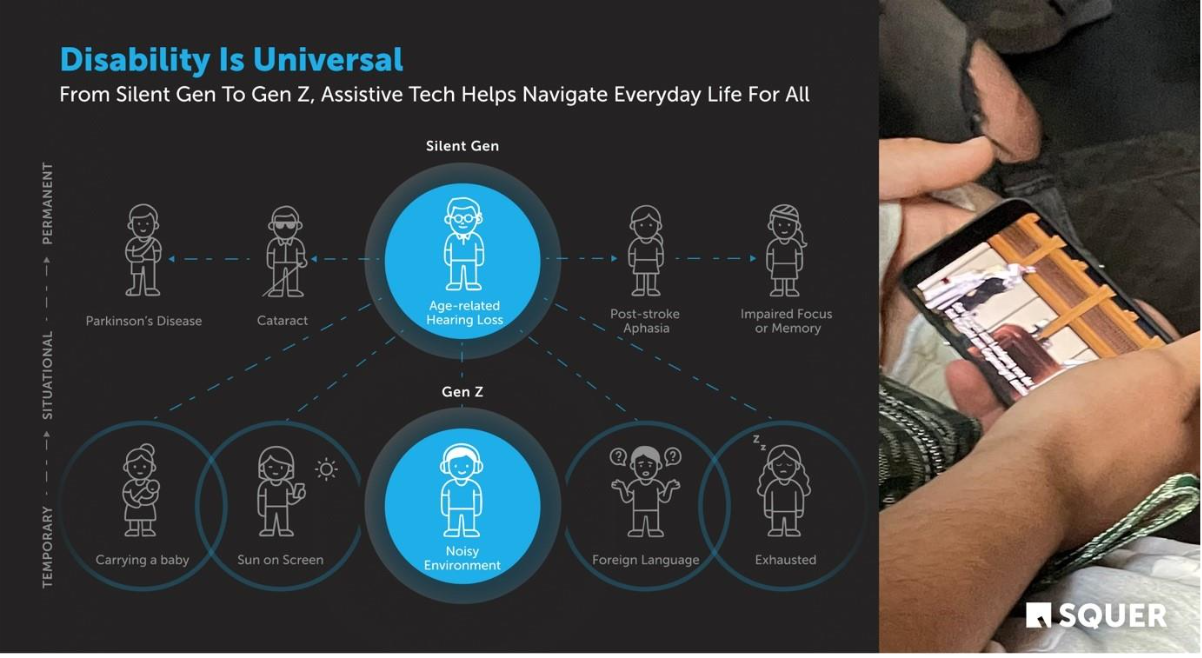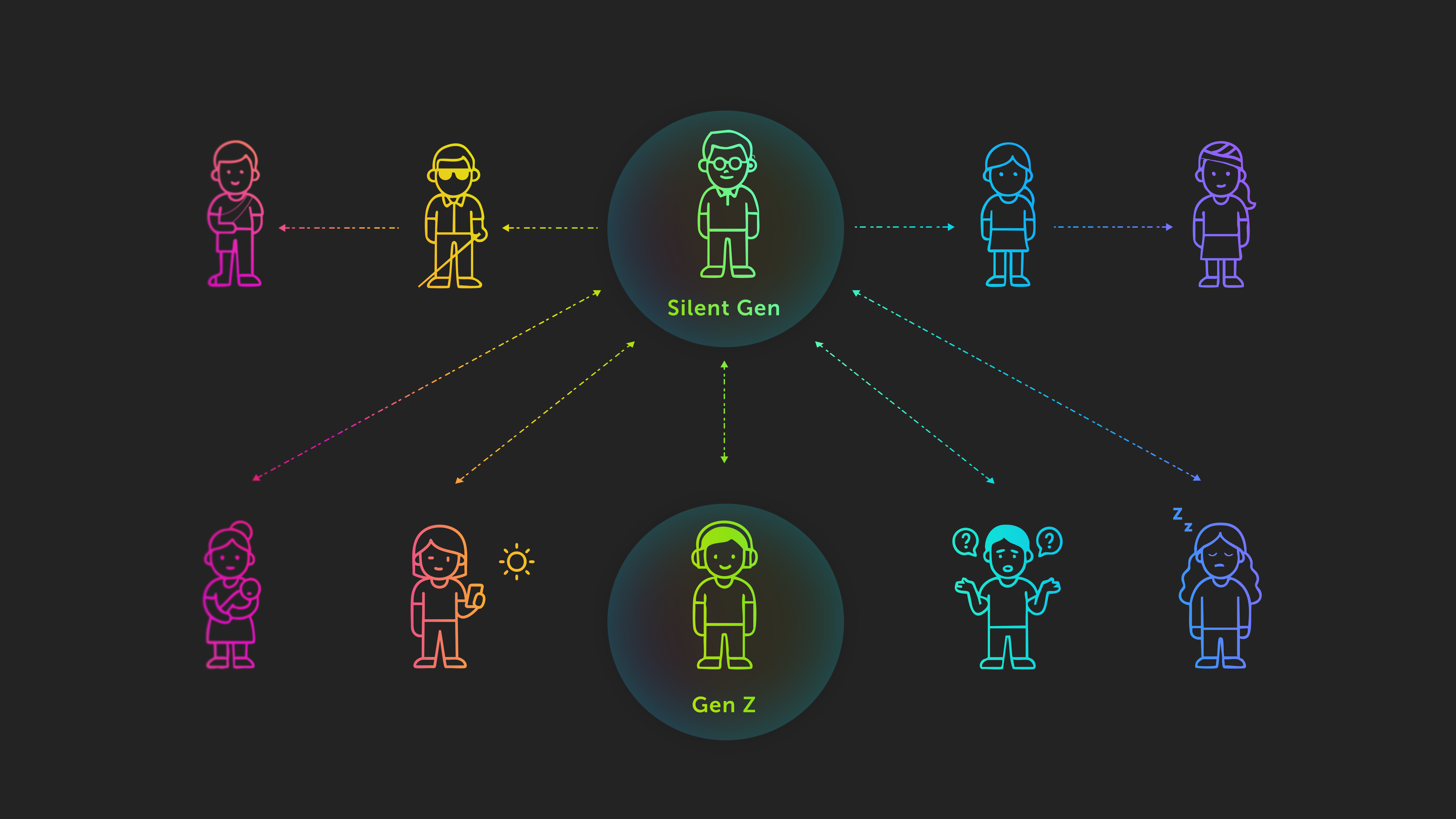By embracing features like captions and prioritizing seamless, inclusive experiences, Gen Z is helping bring accessible design into the mainstream. Their influence is shaping industry expectations and encouraging companies to prioritize usability for all. In parallel, accessibility standards such as WCAG 2.2 and the upcoming WCAG 3.0 are evolving to address a broader range of user needs, including cognitive accessibility and personalization. As digital norms evolve, one thing is clear: accessibility is shaping the future of inclusive user experiences.
Part 1: Gen Z’s Role in Shaping Accessibility
Intro Paragraph
Gen Z is reshaping digital experiences through both their fluency with technology and their everyday habits. Whether watching videos with captions or supporting brands that value inclusivity, their preferences are helping bring accessibility into the mainstream. This article explores how Gen Z’s digital behavior is influencing inclusive design and why businesses should pay attention if they want to stay relevant.
The Influence of Gen Z on Digital Accessibility
Gen Z, typically born between 1997 and 2012, is embracing accessibility in ways that previous generations did not. A survey highlighted by Axios revealed that 59% of Gen Z and 52% of millennials regularly use subtitles when watching shows or movies.1 Moreover, a study by Verizon Media and Publicis Media found that 69% of consumers view videos with the sound off in public places, and 25% do so in private settings. Additionally, 80% of consumers are more likely to watch an entire video when captions are available.2
Why Gen Z Is Turning Away from Voice Assistants, but Embracing Voice Tech
While Gen Z is increasingly distancing itself from traditional voice assistants, there is a remarkable rise in their use of GenAI tools such as ChatGPT, as well as a growing adoption of accessibility features like speech recognition and voice notes. A study published in SpringerLink shows that Gen Z regularly interacts with AI-powered voice assistants, though concerns about privacy and limited usefulness have affected satisfaction levels.3 At the same time, voice-based communication remains highly popular - 33% of Gen Z smartphone users now regularly use voice notes, up 10% over the past three years, citing speed and convenience as key factors.4 Reports also suggest that Gen Z is one of the most active groups driving the adoption of speech recognition and voice tech across applications, helping push the global speech recognition market to a projected $31.82 billion by 2025.5 This shift reflects Gen Z’s broader embrace of intuitive, accessible, and hands-free technologies, both for productivity and inclusivity.
Gen Z drives Accessibility from captions to voice tech
Key insights at a glance:
- Captions Boost Engagement: 80% of people are more likely to finish a video when captions are available
- Subtitles are Normalized: 59% of Gen Z regularly use subtitles, even without hearing impairments
- Voice Tech on the Rise: Gen Z is one of the most active adopters of speech recognition, driving global market growth
- Voice Notes Gain Popularity: 33% of Gen Z smartphone users now use voice notes regularly, citing speed and ease of use
- From Voice Assistants to GenAI: While interest in traditional voice assistants is declining, Gen Z increasingly turns to GenAI tools like ChatGPT
- Accessibility Is Universal: Accessibility features benefit everyone, not just people with disabilities
Gen Z Is Making Accessibility Mainstream
Gen Z is at the forefront of pushing for digital inclusion. Their widespread use of accessibility features, such as captions to watch videos without sound in noisy environments or voice notes for convenience, reflects a shift toward making these tools a standard part of everyday digital experiences. Their embrace of speech recognition and GenAI tools further underscores a broader move toward intuitive, hands-free, and user-friendly technologies that support both productivity and inclusivity.
But Gen Z’s influence on accessibility goes beyond personal convenience. Their digital-first mindset has helped normalize inclusive design, prompting companies to rethink outdated and exclusionary user experiences. This generational shift also reflects a growing demand for assistive technologies that address situational disabilities, such as the temporary limitations commuters face on crowded subways or while multitasking, broadening the scope of what inclusive design must accommodate.
Redefining Expectations for Inclusive Technology
These behaviors provide compelling evidence that Gen Z expects technology to be intuitive, flexible, and usable by all people, including those with disabilities. As the first generation to grow up entirely in a digital world, they demand seamless, accessible interactions. Their vocal advocacy on social media, expectation of ethical and inclusive design, and loyalty to accessible brands are reshaping the standards of digital accessibility. Companies that fail to align with these expectations risk not only regulatory consequences but also alienating a key demographic.
This shift also reveals a deeper, often unspoken cultural change: the internalized expectation that accessibility is not a bonus feature but a digital default. The growing popularity of features like captions, voice commands, and adaptable interfaces highlights a collective move toward inclusive design that supports diverse user needs, whether that’s difficulty hearing in loud environments, limited dexterity during everyday tasks, or other temporary and environmental constraints.
The Other Side of the Spectrum: Older Generations Are Speaking Up Too “I’m old, but not an idiot”

At the same time, digital accessibility has its limits when it comes to human needs and service - older generations also have the right to digital simplicity and access to offline alternatives. In 2022, a 78-year-old retired doctor from Spain launched a protest campaign demanding longer opening hours at his local bank. As more banks closed physical branches and pushed customers toward online banking, he gathered over 600.000 signatures advocating for extended in-person service.
When Tech Moves Faster Than People Can Adapt
Older adults often struggle to keep pace with rapid technological change, not because of unwillingness, but due to a lack of human support and inclusive design. As people age or live with certain disabilities, it’s natural to find it difficult to adapt to rapid technological shifts, especially when those changes are designed to replace human jobs and reduce personal contact. His campaign, titled “I’m old, not an idiot,” underscored how digital transformation can inadvertently exclude and alienate older users.
Supporting Digital Inclusion for All Ages
Designing with older users in mind means recognizing these common needs:
- Simplicity Matters: Aging users demand intuitive, low-barrier access to digital and offline services
- Digital Alone Excludes: Removing human service options risks isolating older and less tech-savvy individuals
- Empathy Is Key: Designing for all ages means understanding physical, cognitive, sensory, and situational limitations that can change over time
- Disability Affects Us All: Nearly 100% of people will experience a disability, temporary or permanent, at some point in life (World Health Organization)

Universal Design Means Designing for Every Generation
In the mid-1980s, American architect Ronald L. Mace shaped a timeless concept of Universal Design and its seven principles. He himself used a wheelchair due to polio contracted in childhood and advocated for designing products and environments to be usable by all people, to the greatest extent possible, without the need for adaptation or specialized design. His work laid the foundation for today’s inclusive design principles, which aim to make environments accessible and usable by everyone, regardless of age, ability, or status in life. The seven principles emphasize equitable, flexible, simple, and intuitive use. They also promote clear communication of information, tolerance for error, low physical effort, and inclusive size and space - ensuring that accessibility is integrated from the start, not added as an afterthought.
Disability becomes increasingly common with age:
According to Eurostat, while only 8.3% of EU residents aged 16–24 report activity limitations due to health problems, that number rises to 74.8% among people aged 85 and older. Disability, particularly involving mobility, vision, hearing, and cognitive function, is not a rare scenario but a common part of aging. Given these numbers, it becomes clear that universal design is essential to support large and growing demographic groups.6
In summary, aging brings rising and multiple disabilities and calls for holistic accessibility
- Disability prevalence increases with age: From 8.3% in young adults to 74.8% in adults aged 85 and older, age strongly correlates with higher disability rates.7
- Multiple disabilities are widespread in old age: 41.8% of individuals aged 75 and older report four or more co-occurring disabilities, indicating the need for holistic accessibility approaches.8
- The most common impairments among older adults include mobility issues such as arthritis and post-stroke impairment, vision loss like macular degeneration and cataracts, hearing decline, and cognitive changes such as memory loss or reduced attention span.9
We’re All Just One Moment Away – Why Inclusive Design Is Everyone’s Future
Designing for the edge helps everyone in the center because disability, in all its forms, affects us all eventually.
When we recognize that addressing the diverse accessibility needs of people with situational, temporary, or chronic impairments such as fatigue, a broken arm or dyslexia is something that affects us all at some point in our lives, we begin to understand what inclusive design means. Fatigue, for instance, can mirror the cognitive load associated with aging, reinforcing the importance of simple, user-friendly interfaces that support all users in moments of reduced focus or ability. Especially because permanent, age-related disabilities often combine with the long-term effects of accidents, as well as situational and temporary impairments, it is essential to approach this generation with an extra measure of empathy. As the World Health Organization notes, disability is part of the human condition. Almost everyone will experience a temporary or permanent impairment, and those who live to old age will face increasing functional challenges. Accessibility therefore benefits not just a few, but is a universal requirement that improves life for everyone of any age, either directly or indirectly through a family member.
Innovation Through Inclusion: Why Apps Must Do Better
Yes, despite the availability of some accessible apps, there’s still significant room for improvement in mobile app accessibility. A 2025 report by Crip Life™ reveals that approximately 70–80% of top mobile apps across various industries remain inaccessible to users with disabilities, indicating a substantial gap in inclusive design.
In terms of simplicity and accessibility thinking, the app industry still has plenty of room for growth and innovation. So what are we waiting for? Let’s start designing innovative and impactful accessible digital experiences that are more helpful than anything we’ve seen before.
What’s Next: The Future of Accessibility Standards
In the next part of this article series, we explore how accessibility standards like WCAG 2.2 and the upcoming WCAG 3.0 are evolving to address cognitive accessibility, personalization, and mental well-being. We’ll look at what this means for inclusive product development and how organizations can proactively prioritize accessibility as an essential part of inclusive product development, rather than treating it as a post-launch compliance issue.
_______________
[1] https://www.axios.com/2023/08/20/gen-z-millennials-tv-movies-subtitles
[3] https://link.springer.com/chapter/10.1007/978-3-031-39811-7_9
[4] https://techround.co.uk/tech/generation-z-smartphone-users-drive-voice-note-adoption
[5] https://intellias.com/from-touch-to-sound-how-voice-technology-is-changing-the-iot-landscape
[6] https://ec.europa.eu/eurostat/statistics-explained/index.php?title=Population_with_disability
[7]https://ec.europa.eu/eurostat/statistics-explained/index.php?title=Population_with_disability
[9] https://www.who.int/news-room/fact-sheets/detail/ageing-and-healt




